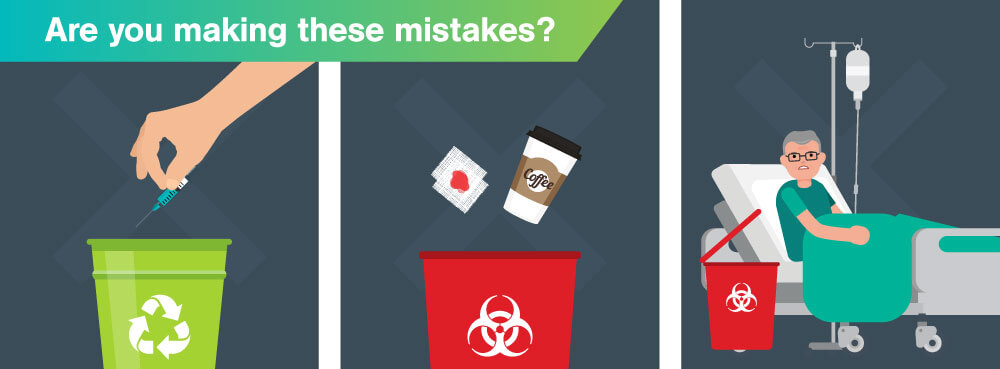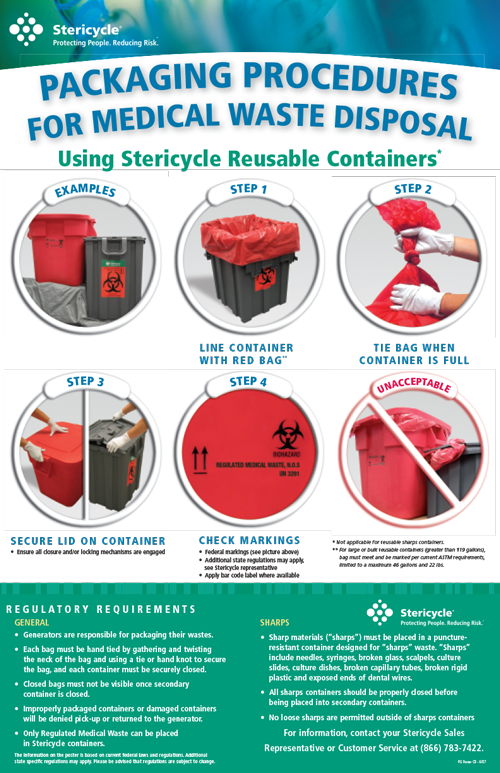Safe and Reliable Medical Waste Removal: Your Trusted Environmental Partner
Wiki Article
Compliance and Rules for Medical Garbage Disposal
Compliance and laws for medical waste disposal play a critical function in ensuring the safety and well-being of both healthcare experts and the basic public. Appropriate management of clinical waste is important to avoid the spread of infections, safeguard the environment, and preserve public health. These regulations incorporate various elements, including the classification and segregation of medical waste, appropriate storage and handling procedures, as well as transport and disposal techniques.Importance of Compliance
The importance of compliance with policies for medical garbage disposal can not be overstated. Proper disposal of clinical waste is important for ensuring the security and health of medical care workers, individuals, and the basic public. Medical waste, that includes things such as used needles, contaminated gloves, and biomedical waste, can present serious health and wellness threats otherwise dealt with and gotten rid of correctly.Conformity with regulations makes sure that clinical waste is taken care of in such a way that lessens the possibility for exposure to harmful substances and transmittable illness - medical waste removal. It assists stop the spread of infections, such as HIV, liver disease B and C, and various other bloodborne microorganisms. Conformity additionally plays an important role in securing the setting by preventing contamination of water resources, soil, and air
Failure to conform with guidelines can cause extreme consequences for healthcare centers, consisting of fines, lawful action, and damage to their track record. Furthermore, non-compliance might jeopardize the health and wellness of medical care workers, people, and the community.
Conformity with laws for medical garbage disposal calls for adherence to particular standards and methods. These may include correct partition, packaging, labeling, and storage of clinical waste. It additionally involves utilizing authorized disposal approaches, such as incineration, autoclaving, or landfilling, depending upon the kind of waste.
Governing Agencies and Bodies
Governing agencies and bodies play a vital duty in overseeing compliance with policies for medical waste disposal. These organizations are in charge of establishing methods, standards, and requirements to guarantee the proper and safe handling of clinical waste. They monitor and enforce conformity to shield public wellness and the atmosphere.One of the most prominent governing firms in the USA is the Epa (EPA) The EPA is accountable for managing the storage space, transportation, treatment, and disposal of clinical waste. They establish guidelines for waste generators, transporters, and therapy facilities to follow, ensuring that all necessary preventative measures are required to avoid the spread of diseases and contamination.
An additional essential regulatory body is the Occupational Safety And Security and Health And Wellness Administration (OSHA) OSHA establishes laws and requirements to protect employees from work hazards, consisting of those pertaining to clinical waste. WasteX Medical Waste Disposal. They provide standards for the safe handling and disposal of medical waste to shield workers in medical care facilities
In enhancement to these federal companies, specific states also have their very own regulatory bodies that manage clinical waste disposal. These companies might have their own certain laws and demands that need to be followed.

Classification and Partition of Clinical Waste
To ensure appropriate monitoring of clinical waste, it is necessary to classify and segregate it according to established methods and standards. medical waste disposal service. Category and segregation play a crucial role in decreasing the risk of infection, protecting the atmosphere, and making sure the safety and security of health care employees and the basic publicClinical waste is identified right into different categories based on its prospective danger degree. These groups consist of infectious waste, pathological waste, sharps waste, pharmaceutical waste, chemical waste, and radioactive waste. Each category requires particular handling, disposal, transportation, and storage space approaches to minimize the threat of direct exposure and contamination.
Partition of clinical waste entails dividing various sorts of waste at the source. This process ensures that waste with different hazard degrees is not combined, lowering the possibility for cross-contamination and making disposal treatments a lot more effective. Proper segregation is attained via using color-coded labels and containers, which help healthcare employees and waste administration workers identify and handle each kind of waste appropriately.
In enhancement to classification and segregation, medical care centers should also stick to regional, state, and federal laws relating to medical waste management. These laws describe specific needs for storage, transportation, therapy, and final disposal of clinical waste, guaranteeing compliance and preserving public health and safety and security.
Appropriate Storage Space and Managing Procedures
Proper storage space and managing treatments play a crucial role in making certain the certified and risk-free management of clinical waste. Medical waste, which includes things such as utilized syringes, contaminated handwear covers, and expired drugs, can present serious wellness and environmental threats if not handled properly. Therefore, it is critical for health care facilities and other generators of clinical waste to carry out strict storage and taking care of procedures.
To begin with, clinical waste ought to be saved in durable, leak-proof containers that are especially developed for this function. These containers should be identified with the global biohazard icon and the words "clinical waste" to plainly indicate the components. In addition, the containers should be kept safely near to prevent any type of possible leak or spillage.
Additionally, it is very important to segregate different kinds of medical waste to avoid cross-contamination. Sharps, such as needles and scalpels, must be stored in puncture-resistant containers to decrease the danger of injuries - WasteX Medical Waste Disposal. Chemical waste, such as anti-bacterials and solvents, need to be kept individually from various other sorts of clinical waste to prevent chemical responses or hazardous direct exposures

Transport and Disposal Methods
Healthcare centers need to guarantee the safe transport and appropriate disposal of their medical waste to abide by guidelines and safeguard public wellness. Transport and disposal methods play a crucial function in avoiding the spread of transmittable illness and reducing the ecological effect of clinical waste.
To deliver medical waste, healthcare centers ought to make use of watertight and puncture-resistant containers that are identified with the biohazard symbol. These containers must be securely secured to prevent any type of leakage during transport. Furthermore, medical care facilities need to establish procedures for the transport process, consisting of making use of specialized vehicles and skilled employees.
Once the medical waste gets to the disposal center, it undergoes different approaches of treatment. One typical approach is incineration, which involves burning the waste at high temperature levels to damage pathogens and minimize the quantity of waste. Another method is autoclaving, which utilizes vapor and stress to sanitize the waste. After therapy, the waste is normally sent to a garbage dump or a waste-to-energy center for last disposal.
It is essential for health care centers to collaborate with licensed and allowed waste monitoring business to make certain proper transport and disposal of medical waste. These companies have the expertise and sources to handle clinical waste safely and in compliance with regulations.
Verdict
Finally, compliance with policies for medical garbage disposal is of utmost significance to make certain public health and safety and security. Governing agencies and bodies play a vital duty in implementing these guidelines. Proper category and partition of medical waste, as well as adhering to proper storage and handling treatments, are vital to avoid contamination and the spread of diseases. Ample transport and disposal methods have to be carried out to minimize ecological effects. Overall, adherence to conformity and regulations is necessary to successfully take care of clinical waste.Medical waste, which consists of products such as utilized needles, polluted handwear covers, and biomedical waste, can position significant health and wellness threats if why not try here not handled and disposed of appropriately.
These categories include transmittable waste, pathological waste, sharps waste, pharmaceutical waste, chemical waste, and radioactive waste.Segregation of clinical waste entails separating different kinds of waste at the resource. Proper partition is attained through the use of color-coded tags and containers, which help health care employees and waste monitoring personnel determine and manage each kind of waste properly.
Chemical waste, such as anti-bacterials and solvents, should be kept individually from various other kinds of clinical waste to prevent harmful direct exposures or chemical responses.
Report this wiki page